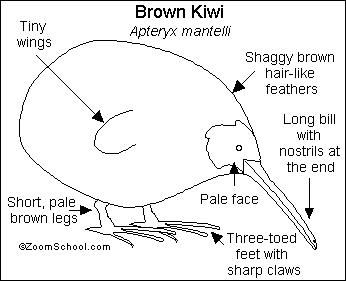
 |
| You might also like: | Dinornis Printout | Tuatara Printout | Moa Printout | New Zealand Animal Printouts | Kakapo Printout | Today's featured page: Keel-Billed Toucan Read-and-Answer Quiz |
| More Information on Birds | EnchantedLearning.com Kiwi | Animal Printouts Label Me! Printouts |


The kiwi is generally nocturnal (most active at night). It belongs to the group of ratites, flightless birds that also include the ostrich, emu, and rhea. There are 6 species of kiwi (genus Apteryx). The kiwi is in danger of extinction.
Anatomy: The kiwi has a long, pointed bill, with nostrils at the end. Its feathers are brown, rough, and shaggy, and its wings are only 2 inches (5 cm) long; it is incapable of flight. The kiwi has short but powerful legs which it uses to run, to burrow in the soil, and to kick. It has very sharp claws on its 3-toed feet. This bird has no tail. Kiwis range from 18 to 33 inches (45 to 84 cm) long and are about 1 ft (30 cm) tall. They weigh from 2 3/4 to 9 pounds (1.25 to 4 kg). The female is larger than the male.
Eggs and Chicks: Females lay an egg that is 1/5 of their own body weight; the egg is about 5 inches (13 cm) long. The white to pale-green egg is laid in a burrow that the female digs with her feet. There are 1 to 2 eggs in each clutch (a set of eggs laid in one nesting period). A female will produce 2 to 3 clutches each year. The male kiwi incubates the eggs.
Diet: The kiwi eats insects, worms and spiders. It will also eat seeds and fruit. It catches bugs with its long beak; the beak is poked into the soil to disturb bugs. The kiwi then catches and eats the exposed bugs. The kiwi has nostrils located at the tip of the bill which are used to sniff out prey.
Predators: Many animals hunt adult kiwis, including dogs and ferrets. About 95 percent of all chicks are taken by predators, which include cats and stoats (ermines).
| Search the Enchanted Learning website for: |